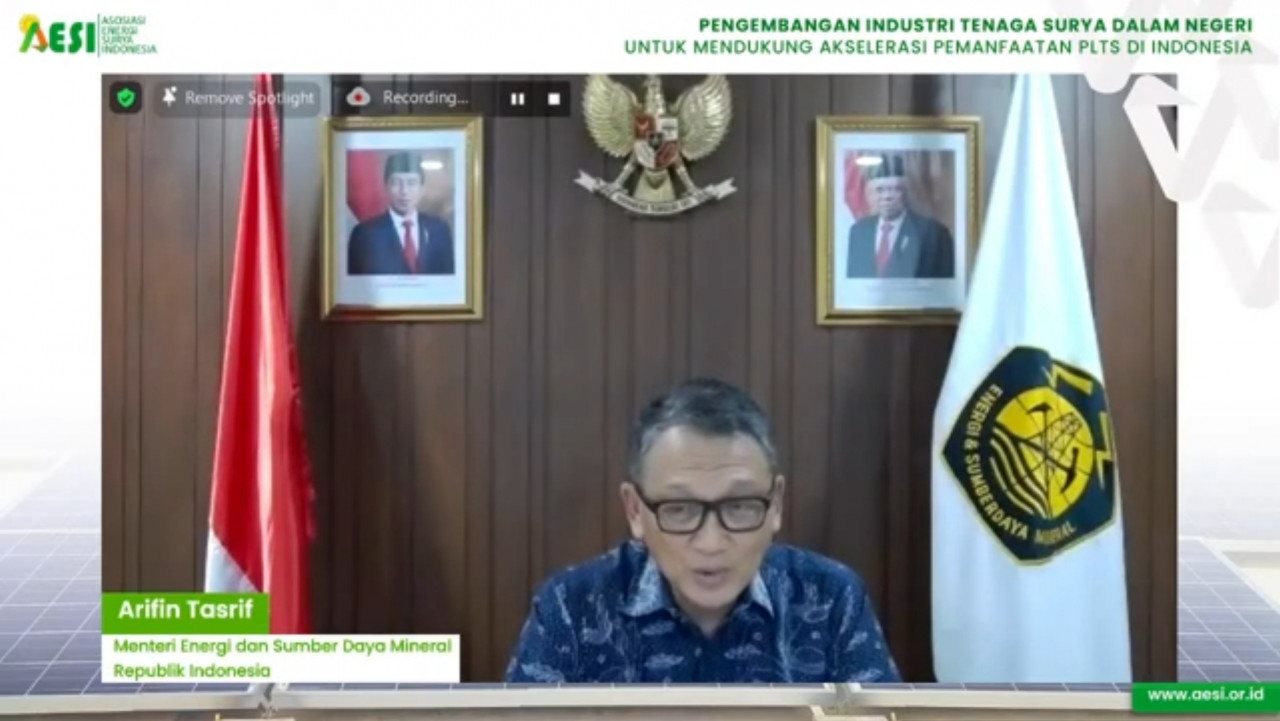
Indonesia to Boost Upstream Solar PV Market
MINISTRY OF ENERGY AND MINERAL RESOURCES
REPUBLIC OF INDONESIA
PRESS RELEASE
NUMBER: 172.Pers/04/SJI/2020
Date: 22 May 2021
Indonesia to Boost Upstream Solar PV Market
The Indonesian government continues its efforts to meet the 23 percent target of new and renewable energy share by 2025. The development of solar photovoltaic (PV) systems is considered to be one of the ideal solutions to meeting this target as well as the challenge of creating a green industry echoed by advanced countries.
"We must follow the advanced countries that are already moving towards green products. Green products can only be supported by green energy. We must immediately respond to this. Otherwise, the domestic industries will be left behind, unable to compete," said Minister of Energy and Mineral Resources (EMR) Arifin Tasrif at the inauguration of the management of Indonesian Solar Energy Association (AESI) for the period 2021-2024. The event was held virtually on Friday (21/5).
If we ignore this condition, Arifin continued, the impact will be prolonged on the domestic industries, for example through the imposition of discriminatory carbon tax. "This will have a further impact on our downstream industries," he added.
For the record, Indonesia's solar energy potential is 207.8 Giga Watt (GW), and only 154 Mega Watt (MW) has been utilized. The Indonesian government dreams of creating an attractive market for investors, especially in the upstream sector. "We must be able to create a market that is significant enough to attract investment in the upstream sector (solar panels). We have enough raw materials, so there will be other effects, for example small-scale industries can grow while micro and small enterprises can participate in the industry," said Arifin.
Arifin said he was trying to design regulations that were in line with the market opportunities he wanted to create. "The Electricity Supply Business Plan (RUPTL) and draft presidential regulation must have a target market that can attract upstream industry to invest," said Arifin.
Currently, one key issue is about local components (TKDN) in the solar PV system or solar panel industries. Thus, the government will also improve regulations about TKDN. "We are currently facing the issue of local components (TKDN). The government supports the TKDN; this is something that must be addressed together by the solar PV industry players," Arifin explained.
He said that binding regulations were needed to open up opportunities in the upstream sector so that investors would come and Indonesia would not be left behind other countries whose solar power industry had already developed.
"Why ACWA Power, a company from Saudi Arabia; Masdar, Mubadala (United Arab Emirates companies), why can they compete in the international market of solar PV system? because they control the upstream sector," Arifin emphasized.
According to Arifin, Indonesia has a large market potential. If this market potential is utilized optimally, opportunities will be created. "We have a large market. Every decade, we can utilize 30, 40, 50, maybe up to 100 GW; we create opportunities together," he explained.
Lower Investment Costs
Arifin estimated that the use of solar PV in the future will soar because investment costs have lowered significantly. In just one decade, he said, the investment cost of solar PV has dropped by 80%.
"In fact, the lowest bid for solar PV development in Saudi Arabia by ACWA Power is 1.04 cent dollar per kWh. The decline in investment is also felt in Indonesia, where the sales price from Cirata 145 MW floating PV power plant is 5.8 cent dollar per kWh," said Arifin.
Based on market sounding by state electricity company PT PLN, the electricity price from floating PV power plants at several locations is offered at 3.68-3.88 cent dollar per kWh.
Solar PV systems are currently the favorite source of energy in the world. Based on the 2020 IRENA data, China is the country with the largest installed capacity of solar energy at 263 GW in 2019. "China is followed by the United States and Japan with an installed capacity of 62 GW and 61 GW, respectively," Arifin concluded. (IY)
Head of Bureau of Communication, Public Information Services, and Cooperation
Agung Pribadi (08112213555)
Share This!






